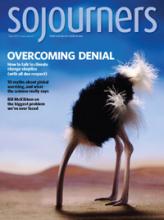Faith leads us into the abyss of death, and these lectionary readings are honest about that journey. It is the death faced by Jesus when he was executed by the empire, the death to which the church is called. Good Friday is about the losses that go with that contradiction.
But the texts are also hope-filled about a move out of that abyss into God’s gift of new life. As Easter is the new life given to Christ, so Easter is the new life offered to the church—and eventually to the world. The crisis among us now in our society is that the new life to which we are called, one of generous hospitality, is not like the old life we have lost. The new life—filled with joy and shaped like forgiveness—is one of demanding resolve and fidelity.
Walter Brueggemann, a Sojourners contributing editor, is professor emeritus at Columbia Theological Seminary in Decatur, Georgia.
[April 3]
Light in a Dark Valley
1 Samuel 16:1-13, Psalm 23; Ephesians 5:8-14; John 9:1-41
We live, from time to time, in “the valley of the shadow of death” (Psalm 23:4). That valley in many forms is marked by risk and threat. But in every such valley we are kept safe, because God has the capacity to guard, protect, and eventually make new. By the end of the psalm, the speaker is safe in God’s “goodness and mercy” (verse 6).
That transformative power of God—to make safe, to fill cups, to set tables (Psalm 23:4-5)—is evident in our two narratives. The prophet Samuel finds a new king for Israel, David, on whom God’s spirit rushes, an act that creates a new possibility for Israel. More spectacular is the healing of the blind man in the gospel narrative. The man bears witness to the power of God to overcome blindness and create new possibility.
Read the Full Article
